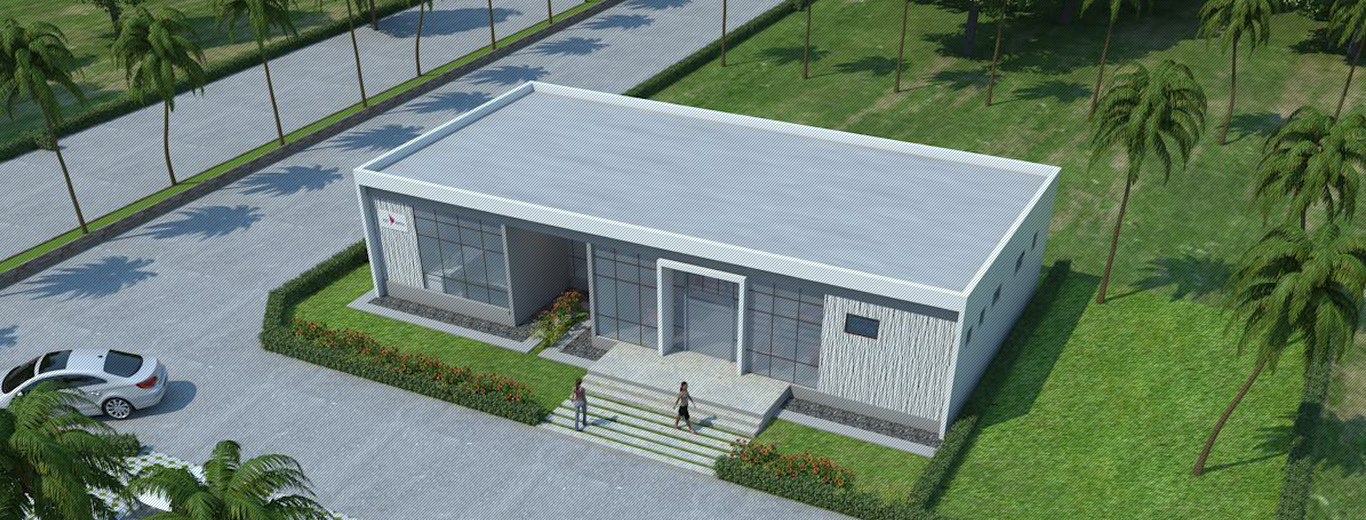What is Curing?
Curing is a pivotal process employed in the production of concrete and other materials, with its primary purpose being to control the rate of hardening and drying after these materials have been shaped or cast.
Curing becomes crucial after the concrete is prepared and installed, initiating a chemical reaction known as hydration. In this process, the water within the concrete mix reacts with the cement, forming a hard, stone-like mass. However, the conditions need to be optimal for this reaction to persist and be effective.
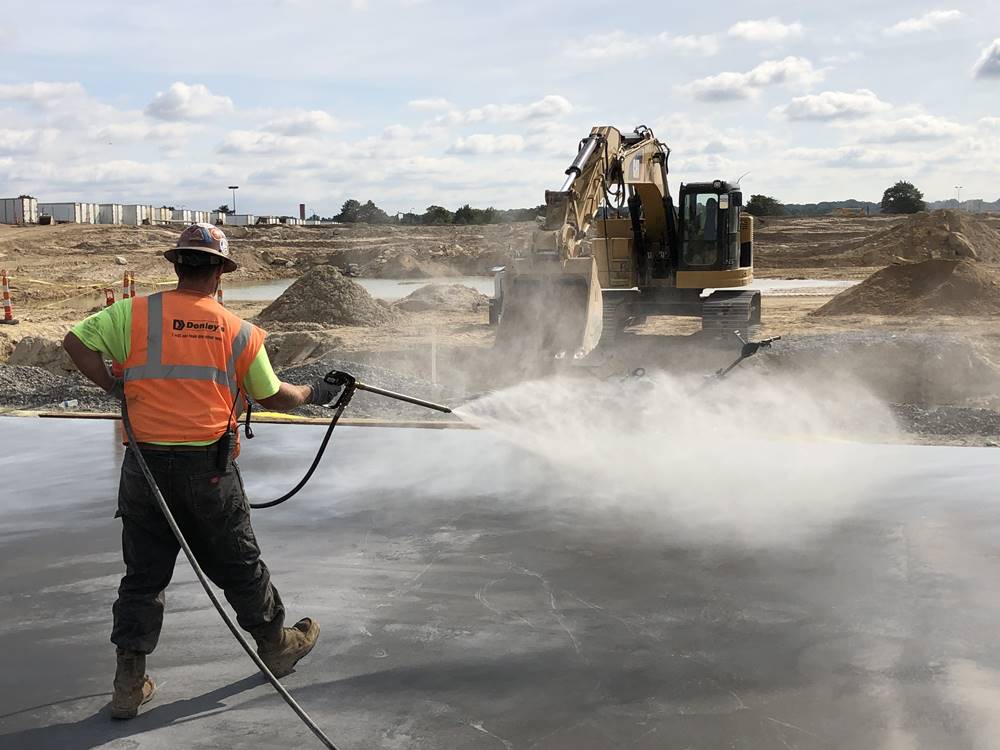
Courtesy: Concrete Decor Magazine
Maintaining the right moisture and temperature levels in the concrete is at the heart of curing. These regulated conditions ensure the hydration process can continue unhindered for an extended period. This continuity is essential for the concrete to attain its maximum possible strength and durability, thereby highlighting the significance of the curing process in producing high-quality concrete.
Why is Curing Needed in Precast Concrete Elements?
Precast concrete elements are cast and cured in a controlled environment before being transported to their final location and installed. Curing is an essential process for these elements for several reasons:
- Strength development: The hydration process, in which the water in the concrete mix reacts with the cement, is responsible for the development of the concrete’s strength. Curing ensures that this process can continue effectively, leading to a stronger and more durable final product.
- Durability: Proper curing reduces the occurrence of cracks, enhances resistance to freeze-thaw cycles and de-icing salts, and improves resistance to abrasion and erosion, which are important for the longevity of the precast elements.
- Dimensional Stability: Curing helps to improve the dimensional stability of the precast elements, reducing the risk of shrinkage or distortion, which can affect the fitting and alignment of the elements on site.
- Quality Control: As precast elements are produced off-site in a controlled environment, proper curing is part of a quality control process to ensure the consistency and reliability of the final product. Without proper curing, variations in strength and durability could occur, which can affect the overall performance of the construction project.
- Speed of Production: Precast concrete elements often need to be demolded and moved to make room for the next batch. Curing, particularly accelerated curing methods like steam curing, can help the elements reach their design strength faster, increasing the speed of production.
What are the Curing Methods for Precast Concrete Elements?
The process of curing concrete is crucial to ensuring that it achieves its desired hardness and strength. Precast concrete elements, which are cast and hardened before they are installed at their final location, have a variety of curing methods available. Here are some of the common methods:
- Steam Curing:
Precast concrete plants often need to achieve high concrete strengths within a few hours to meet construction timelines. To attain this, heat curing methods, such as steam curing, are commonly used in the industry. Steam curing involves exposing the newly cast concrete elements to elevated temperatures, typically between 140°F-180°F (60°C-82°C). This process accelerates the curing process, enabling the concrete to reach its design strength in a significantly shorter period.
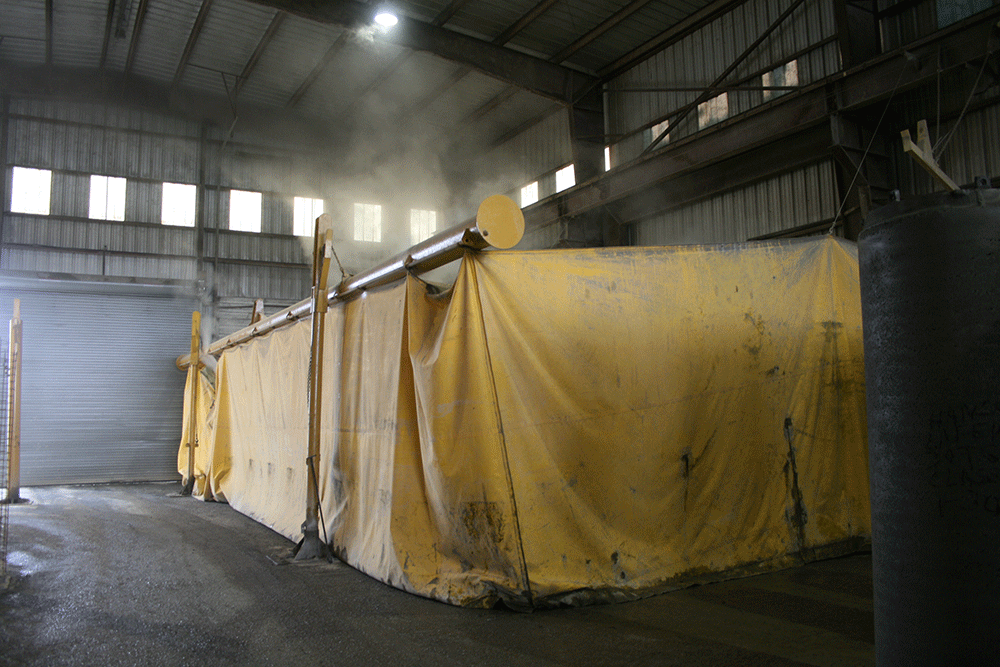
Courtesy: National Precast Concrete Association
The main engineering benefit of this heat curing approach, particularly steam curing, is the attainment of high early strength. This method also contributes to reducing creep and shrinkage—major factors affecting prestress losses in prestressed concrete—by up to 50% and 30%, respectively. Consequently, prestress loss may be reduced by up to 40%.
Furthermore, the use of heat curing brings about economic advantages and practical benefits, offering the precasting technology a significant edge in ensuring the speedy supply of elements needed for construction. In common practice, concrete elements can be heat-cured overnight and demoulded the next day, ready for use. This quick turnaround of formwork and minimized storage space requirement when heat treatment is employed are key contributors to the success of concrete precasting technology. Thus, steam curing not only aids in meeting the demands of construction timelines but also adds economic efficiency to the process. However, in India, any establishment that plans to install a boiler, including those used in curing concrete, must adhere to the regulations put forth by the Boiler Act of 1923, or its most recent version.
- Water Curing:
Water curing is one of the most effective ways to cure concrete. This active system requires specific equipment and procedures and involves methods such as ponding, where a water pool is created on the surface; immersion, which involves submerging the concrete in water; spraying or fogging; and wet coverings. Notably, wet coverings often utilize materials like burlap or cotton mats that are used in conjunction with soaker hoses for a period of time to soak the concrete. This approach maintains the concrete’s moisture and traps the internal moisture at the optimal level for hydration, which is crucial for the process that gives concrete its strength.
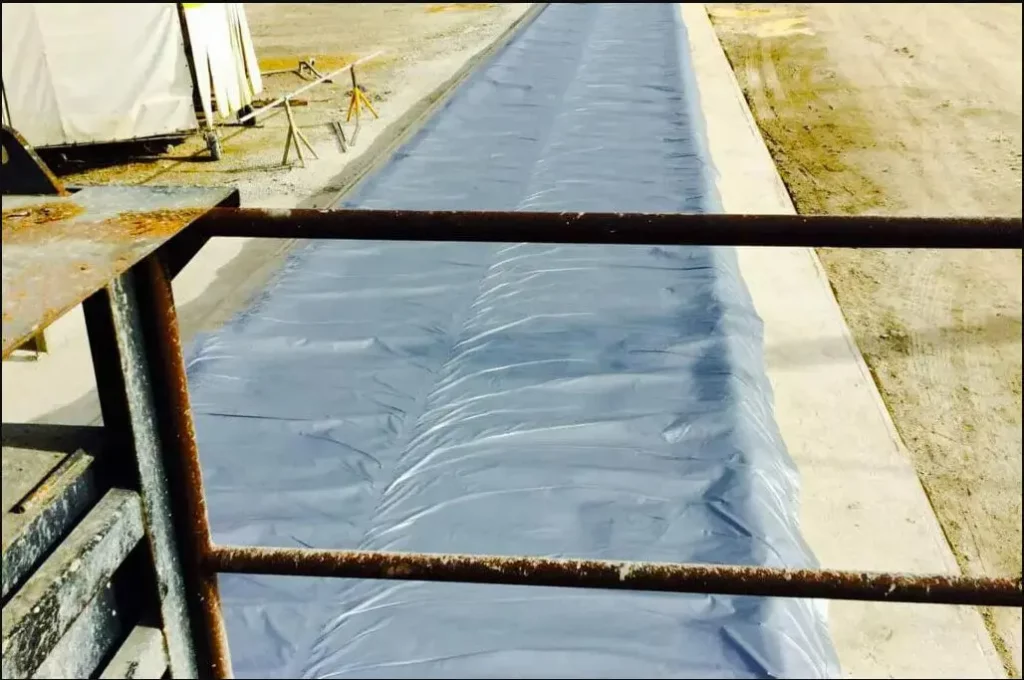
Courtesy: Custom Tarps- Tarp Factory
Moreover, water curing is commonly used in hot climates to regulate the internal curing temperature, preventing it from reaching levels that could hinder effective curing practices. Such a system is particularly effective for Department of Transportation (DOT) projects/products, where high-quality, durable concrete is a necessity. In essence, this method ensures that the concrete remains moist, an essential condition for the ongoing hydration process, thus contributing to the overall strength and durability of the final product.
- Mist Curing:
In mist curing, a fine spray of water is continually applied over the concrete. It’s an effective way to maintain the necessary moisture content and prevent the concrete from drying out too quickly.
- Curing by Covering:
This method involves covering the concrete with an insulating material like straw or sawdust. This maintains the temperature and helps prevent moisture loss during the initial curing period.
- Electrical Curing:
Electrical curing is a process where an electrical current is passed through the concrete to speed up the curing process. This method is typically more costly and requires specific expertise, so it’s not commonly used.
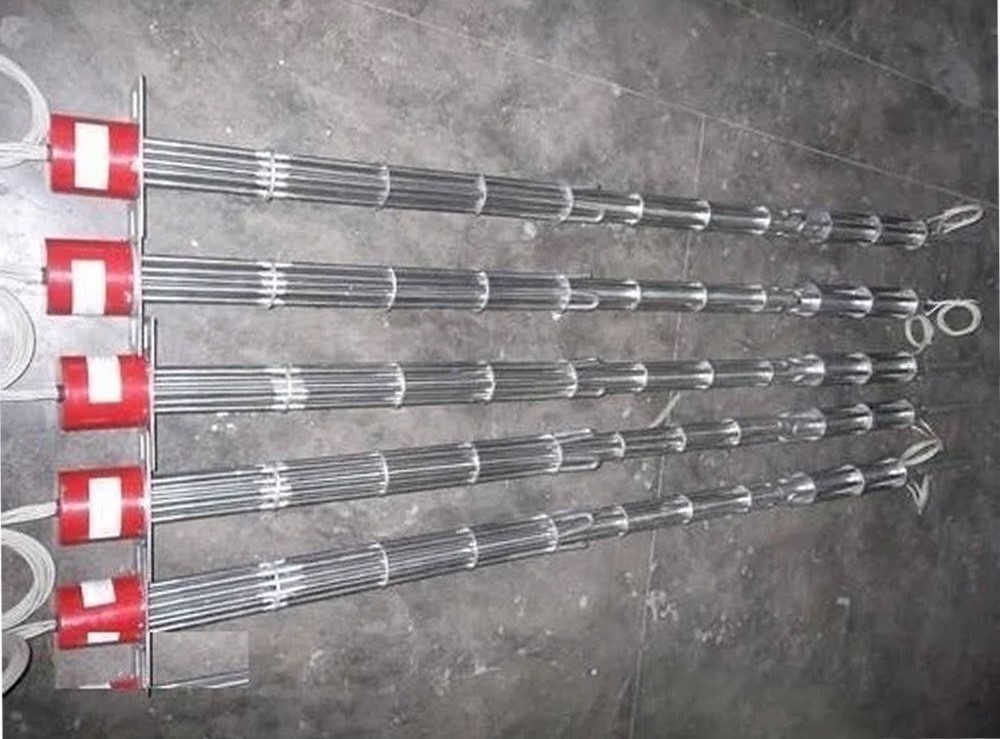
Courtesy: India MART
- Internal Curing:
This method involves using lightweight, porous aggregates that have been pre-saturated with water. These aggregates release water over time, providing internal moisture that aids in the hydration process.
- Curing Compounds:
Curing compounds play a crucial role in the production of precast concrete elements by forming a protective layer that retains moisture in the concrete mix, facilitating optimal hydration. Curing compounds are typically composed of waxes, resins, and other materials that, when applied to the surface of fresh concrete, react with calcium hydroxide (a by-product of cement hydration) to form a semi-permeable membrane.
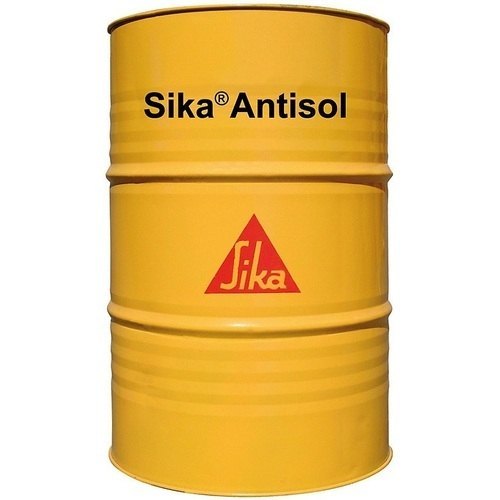
Courtesy: India MART
This membrane acts as a barrier to moisture loss, effectively sealing off the concrete’s pores and trapping water within the mix. The preserved moisture ensures that the water-cement ratio remains constant, thus promoting continued hydration of the cement particles. Moreover, by preventing rapid moisture loss, curing compounds also mitigate the risk of premature drying shrinkage, which can lead to cracking, curling, or other forms of dimensional instability in the precast element.
- Green Curing
KRAFT’s innovative concrete curing system harnesses waste heat energy from hydraulic pumps and air compressors involved in concrete production. The captured heat, transferred via liquid and air-based heat exchangers to an insulated tank, is used to maintain the required temperature in the curing process. A supplemental water heater elevates and circulates the heat within the system. This single atmosphere curing system, capable of capturing around 1,200 kWh of waste heat in an 18-hour shift, minimizes the dependency on traditional energy sources like propane or natural gas. Consequently, it offers significant energy savings and reduces carbon emissions in concrete manufacturing.
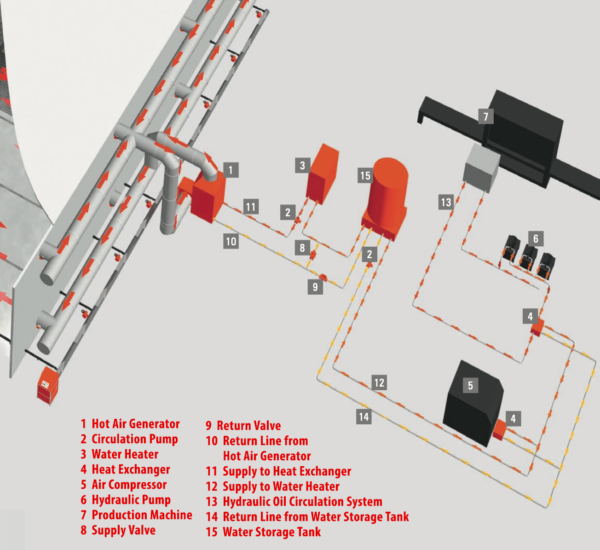
Courtesy: Kraft Curing
Conclusion
Methods such as water curing, steam curing, and curing compounds each have unique advantages and applications. They serve to maintain optimal hydration conditions, regulate internal temperatures, reduce shrinkage, and speed up production times. Effective curing methods and practices remain paramount with the increasing demand for high-quality, durable, and reliable precast concrete elements in construction. Ultimately, the chosen curing method should balance efficiency, cost, and the specific requirements of the produced concrete.
References
- https://www.pcigulfsouth.org/blog/2020/2/21/precast-curing-systems
- Heat Curing Practice In Concrete Precasting Technology – Problems And Future Directions by S. O. Ekolu
- Curing Methods Of Precast Concrete Elements by Mezghiche et al., 2006, Asian Journal Of Civil Engineering (Building And Housing) Vol. 7, No. 6 (2006), Pages 581-589
- https://www.kraftcuring.com/extreme-green-concrete-curing/

